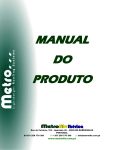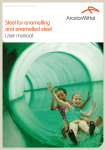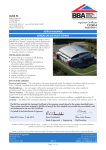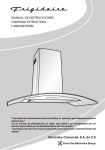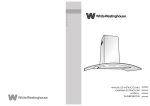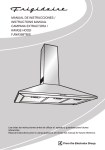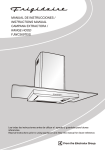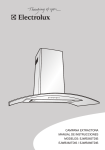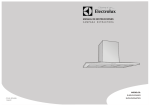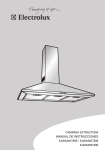Download Manual de Instalación ( pdf )
Transcript
MANUAL DE PRODUCTOS Rua do Calvário, 123 – Apartado 48 – 4905-909 BARROSELAS PORTUGAL +351 258 770 360 + 351 258 770 369 ! [email protected] www.metrotile.com.pt EL PRODUCTO… Manual de Productos – Pagina 2/39 El sistema de cubiertas METROTILE tuve su origen en Nueva Zelanda en 1946. En esto momento es vendido en todo el Mundo e tiene fábricas en Nueva Zelanda, EE.UU. e Bélgica. Sus principales ventajas: Tejas grandes (solo 2 tejas/m2) Muy fácil instalación; Costes muy bajos de montaje; Costes muy bajos de almacenaje y transporte; Liviana (pesa solo 7 Kg./m2); Muy agradable estéticamente; Ruido de la lluvia igual a la teja cerámica; Resistencia al viento (resiste a 200 Km./h); Sin costes de manutención; Bueno aislamiento térmico e acústico; Disponible en 6 colores Standard; Manual de Productos – Pagina 3/39 Permite pendientes mínimos de 10º; Permite caminar por arriba; Resistente al fuego – Índice A; Resistente a la proximidad del mar; Resistente a choques térmicos; Vasta gama de accesorios; Garantía 30 años; Producto Certificado ISO 9001:2000 Manual de Productos – Pagina 4/39 Manual de Productos – Pagina 5/39 EL SERVICIO… Manual de Productos – Pagina 6/39 Además de tener un excelente producto, METROTILE se distingue por un servicio pensando en el cliente, do cual destacamos el siguiente: Entregas muy rápidas – de 2 a 8 días laborables. (tenemos un stock permanente de más de 200.000 m2 de teja) Hacemos accesorios a la medida del cliente; (*) Podemos hacer cualquier color al gusto del cliente; (*) Desarrollo continuo de nuevos productos, presentando normalmente entre 2 a 3 productos nuevos por año. Busca contínua de soluciones de cubierta mejores, más bonitas y más rápidas de colocar. (*) – Dependiendo de las cantidades del pedido. Manual de Productos – Pagina 7/39 Instrucciones de Montaje Manual de Productos – Pagina 8/39 Equipamiento para la Instalación Cizalla Para fácil transporte, las piernas salen. La lamina es hecha en acero de mola Superficie Ocupada: 3700mm x 1000mm Largo: 1100mm Peso: 29Kg Accesorios para doblar la teja El dibujo muestra la dobladora con el accesorio para las tejas, en la posición correcta. Está fijado á la dobladora con tornillos de 12.5mm e puercas de orejas. Largo : 1600mm Peso : 26 Kg Dobladora Superficie ocupada: Anchura : Peso: : 490mm x 460mm 530mm 25 Kg Vara de Medición (echa en el local) Echo en madera, con 50x25 mm ó 50x40 mm de sección e 3m a 5m de largo, con marcas de intervalos exactos de 370 mm. En alternativa a la madera, la vara podrá ser de aluminio y pode ser echa por el instalador. Otro Equipamiento de Instalación Necesario Tijeras de Chapa Martillo Cinta Métrica Hilo de marcación ó Línea de tiza Tiza (para marcar las tejas) Zapatos de borracha macia Manual de Productos – Pagina 9/39 Embalaje Las tejas son colocadas en paletas de madera, con las dimensiones a seguir indicadas. Producto Por paleta Peso máximo Tamaño Volumen (m3) MetroBond MetroShake 350 350 1085 Kg 1085 Kg 1.4 x1.1 x 0.9 1.4 x1.1 x 0.9 1.38 m3 1.38 m3 MetroBond MetroShake Peso por Teja 3.1 Kg 3.1 Kg Peso / m2 6.66 Kg m2 6.66 Kg m2 Camión Completo: 18 paletas de teja más el suficiente numero de accesorios pueden ser embalados en un contenedor normalizado de 20’. Esta cantidad permite una cobertura de aproximadamente 3000 m2. A pedido, se puede utilizar un embalaje especial para satisfacer exigencias específicas. Almacenamiento Para almacenamiento exterior, se debe providenciar una cobertura de protección para mantener los productos secos e prevenir estropeos. Movimientación Para evitar estropeos de la superficie, debe ser tomado alguno cuidado en la movimientación de las tejas. En el caso de pequeños estropeos debe ser usado el kit de reparación. Manual de Productos – Pagina 10/39 Dados Para los Cálculos Estimativos Cuando se hace la estimativa del número de tejas necesarias, se debe utilizar la tabla que indica los factores a usar para dividir la anchura e el largo del tejado, para calcular el número de líneas de teja e el número de tejas por línea. Anchura de la Teja [m] Largo de la Teja [m] MetroBond MetroShake MetroShingle 0.37 0.37 0.24 1.25 1.25 1.25 1) Estimativa de Tejas para un Tejado de 2 aguas (a) Determine la anchura del tejado (Fig.1) e divida-o por el factor de la teja que va a usar; (b) Determine la longitud total del tejado (Fig.1), e divida-a por el factor de teja que va a usar; (c) Multiplique (a) por (b), asegurando que las tejas fraccionadas son contadas como tejas completas; (d) Para calcular el total de ambos los lados del tejado, multiplique lo resultado por dos. Fig.1 2) Estimativa de Tejas para un Tejado de 4 aguas (a) De inicio, se considera el tejado como un tejado de 2 aguas e calcule como en 1 (a),(b),(c) y (d); (b) Determine la longitud de la cumbrera (Fig.2) y, usando una de las fórmulas referidas en 4, calcule el número de tejas extra que necesita. Suma este número a las tejas necesarias para el tejado. Fig.2 3) Estimativa de Tejas para Tejados con más de 4 Aguas (a) Determine las tejas necesarias para las secciones (a), (b) y (c) da Fig.3 e calcule como en 1(a), (b) y (c) (b) Adicione los totales de (a), (b) y (c) e multiplique por dos, para los dos lados. (c) Determine la dimensión total de las cumbreras y vales, usando la fórmula referida en 4, calcule el número de tejas extra necesarias; (d) Adicione este total al total calculado antes para obtener el total de tejas necesarias. Fig.3 Manual de Productos – Pagina 11/39 4) Estimativa de Tejas Adicionales La cantidad de tejas adicionales para cumbreras e vales pueden ser estimadas usando la siguiente fórmula: Tejas adicionales = Total de las cumbreras y vales en metros lineares x 0,6 (factor de desperdicio) x 2,15 (tejas por metro cuadrado). 5) Estimativa de Accesorios Cuando se hace el cálculo de los accesorios necesarios, se debe incluir algunos más para compensar pierdas. (a) LINEA DE CUMBRERA: Determine la longitud de la cumbrera e divida por la cobertura linear por cumbrera, para calcular el numero de unidades necesarias; (b) REMATES LATERALES: Determine la anchura del tejado e divida por la cobertura linear de cada remate lateral para calcular el numero de unidades necesarias; 6) Estimativa de Rasteles para Nueva Cubierta Se necesita de 3ml de rasteles por metro cuadrado de tejado. 7) Estimativa de Vigas para Reforma de Tejados Se necesita de 5 ml de rasteles por metro cuadrado de área de tejado. 8) Métodos Simplificados para Estimativa Rápida Indicamos abajo algunos métodos para estimativa rápida de cantidades necesarias. a) TEJADOS CON 4 Ó MÀS AGUAS: calcular igual a tejados de 2 aguas, e adicionar media teja por línea para cada cumbrera ó vale para compensar desperdicios; (b) REMATE LATERAL (excepto remate en cascada): una pieza por cada tres líneas de tejas: (c) RASTELES: El numero de tejas más 50% equivalente a los metros lineares de rasteles necesarios; Manual de Productos – Pagina 12/39 Mediciones e Marcación con una tiza. Esto forma la línea de corte (Fig.2). Las mediciones son hechas en el tejado, pero se aconseja que las tejas sean marcadas, cortadas, dobladas y apiladas en el suelo. Para ganar tiempo en la marcación, corte y doblaje de cada teja, se aconseja que el trabajo sea hecho por dos instaladores – uno para medir y otro para registrar lo resultado de las mediciones en el papel. Para evitar confusiones, corte, doble y apile exactamente por su orden. Atención a lo siguiente: (i) La medición básica es hecha a partir de la ultima saliencia del canto inferior de la teja, para el parte superior, en línea con la arista frontal de la vigota (Fig.1) (ii) Mida y marque en las tejas con una tiza, las medidas quitadas del tejado, asegurando que la unión de la saliencia de sobre posición de la teja a cortar, es tomada como la medida del punto de partida (Fig.1). Esto forma una línea de doblaje (Fig.2). ALTERNATIVAMENTE – Haga un molde de ángulo formado por la viga de cumbrera y los rasteles del tejado. Ponga el molde en la teja de modo a que la marca de medición en la parte frontal de las líneas superiores de la teja se una con la parte interior del molde. Marque en línea con la parte inferior de la moldura para definir la línea de doblaje. Cada teja deberá permitir dos piezas cortadas con un mínimo de desperdicios (Fig.2) NOTA: Como las mediciones son hechas en línea con el canto de la viga, las marcas de las medidas en la teja deberán ser, también, en conformidad. Añadir a la medida de la línea de doblaje, la altura de la proyección arriba de la línea de la teja. Marque en las tejas Fig.1 Fig.2 Manual de Productos – Pagina 13/39 Productos de Ventilación Tejas de Ventilación Las Tejas de Ventilación Metrotile fueran hechas para que no sean visibles en su tejado. Fabricadas en PVC estable a los rayos Ultra Violeta, estas tejas están disponibles para combinar con todas las colores padrón Metrotile. Indicadas para su aplicación en una zona de unión, donde las paredes de protección del fuego cortan el espacio del tejado y, aún cuando sus características de concepción dificultan la ventilación cruzada. Las tejas de ventilación Metrotile producen 7500 mm2 de corriente de aire por metro linear. Además de hacer una ventilación efectiva, las Tejas de ventilación Metrotile son extremamente eficaces en la prevención contra la entrada, para el espacio del tejado, de lluvia, nieve y pájaros. Tubo de Ventilación Para una excelente resistencia a la corrosión, los terminales de exhaustión de gases Metrotile (o tubos de ventilación) son manufacturados en acero galvanizado y tratados de modo a que poda obtener un acabamiento igual a los padrones de las tejas. Incorporando un filtro protector para evitar la entrada de pájaros, los terminales dan una resistencia baja a la exhaustión de gases. Además, estos terminales satisfacen todas las reglamentaciones relevantes de la construcción escocesas (Building Regulations and Scottish Building Standards) y, son propias para las aplicaciones até 60KW Manual de Productos – Página 14/39 Montaje de las Tejas Fig.1 Colocación de las Tejas Las tejas pueden ser ligadas entre sí tanto por el lado derecho, como por el izquierdo, pero deben ser colocadas con la orilla escapando a los vientos predominantes y de los tubos de descarga de agua o del canelón. Cuando sea posible, las tejas deben ser colocadas con las orillas a partir del lado normal. Las tejas son colocadas levantando simultáneamente las dos tejas y deslizando la próxima línea debajo de la nariz de las tejas ya colocadas. (Fig. 1) Fig.2 Procedimiento de la Instalación de la Teja – Techo de Cobertura Las Instrucciones Generales para la colocación de la teja, son como se describe arriba. De la segunda línea para o topo, deje el canto del topo de la primera teja a 150mm de la viga del topo del tejado. Continúe colocando tejas até el otro topo, teniendo como referencia la camada anterior e até qué lo espacio sea totalmente cubierto. Fije estas tejas clavando la falange posterior. Deje las camadas subsecuentes dos de cada vez, ambas empezando sensiblemente à la misma distancia de la viga del topo del tejado (Fig. 2). Deberá tener lo cuidado de aliñar a partir de la viga del topo del tejado. Para reducir desperdicios, utilice partes de tejas para completar camadas con aproximadamente 150mm. Esto permite que cada terminal de una teja completa sea cortada e doblada para completar los espacios vacíos. Fig.3 Clavar La posición correcta para clavar las tejas a los rasteles se hace como el indicado en la Fig.3. Las tejas son clavado conforme Fig.4 – los clavos deben quedar a aproximadamente 60mm del lado del centro de la orilla de la teja, o que asegura una buena fijación de la teja. Nota: en áreas propensas a ciclones, la instalación debe seguir las normas e prescripciones legales de la zona. En zonas de vientos normales se debe clavar en cuatro puntos por teja para las dos camadas del topo, para las dos ultimas camadas del final e, también, en el largo de la teja a partir da del topo, vales e remates laterales. Fig.4 Fig.5 MetroShake – 4 clavos por teja, fuera del curso de agua. Técnica de Clavar La persona que está a clavar debe colocar-se como la Fig.5 Fig.6 Primera Teja, junto al Canelón Junto al canelón, las tejas son fijadas por arriba a la viga transversal abajo. El clavo debe ser colocado en la parte superior del perfil de la teja (Fig.6). Para asegurar un completo vedamiento a la agua, el clavo ó tornillo deberá ser vedado. Los clavos ó tornillos en MetroShake deberán estar fuera del curso de las aguas. Manual de Productos – Página 15/39 Fig.7 Topos Corte Utilice una cizalla para cortar por las líneas de corte marcadas. Doblaje Ponga la teja a doblar en la dobladora e aliñe con la línea de doblaje a la vista. Opere el pié del controlo de la dobladora para fijar firmemente la teja, e doble-a para arriba (Fig.7). Cada corte de la teja varia ligeramente en tamaño y, tanto el corte como el doblaje, es hecho en el suelo. Es mucho importante no mezclar las tejas cortadas. Apile-as el la secuencia en que van ser usadas (Fig.8). Fig.8 Instalación para Cortar Tejas Instale todas las tejas cortadas clavando poniendo-as para arriba dentro de la viga de topo, y uno ó más tornillos a través de la arista frontal y la viga (Fig.9), empezando a partir de abajo. Fig.9 Fig.10 Vales Mediciones, Corte y Doblaje La medición, corte y doblaje de los vales es hecha como para los topos, excepto que, aquí, los doblajes son hechos para bajo. Medir la distancia a partir de la ultima saliencia de la teja instalada a la línea de acabamiento sobre el vale (aproximadamente 40mm para cada lado de la línea central del vale (Fig.10). Esta medición es hecha en el topo y el fondo de la teja ya instalada. Esto es la línea de doblaje. A esta medida tendrá que añadir la a profundidad del vale a partir de la línea de la teja acabada menos 10mm a la cual es la parte de la teja que cale en el vale. Esta es la línea de corte (Fig.11) y resultará en un embudado descendente. Corte con la cizalla y, pela línea de doblaje, doble la teja para abajo. Instale de forma normal, esforzando-se por colocar uno clavo próximo del vale, mas no clavado en el vale. Fig.11 Cumbrera Ponga la línea de tejas del topo cuando los largos de las vigotas de arriba están completos con tejas. La arista trasera de la teja debe quedar derecha para fuera. Esta operación es, normalmente, hecha en la dobladora. Ponga la línea de tejas del topo cuando el largo de la da vigota no acomoda una línea completa. Fig.12 Procedimiento Medir la distancia (A), de la última teja a la línea de la cumbrera (Fig.12). Se debe añadir 50mm à la medida encontrada (vire para arriba la dobla aconsejada) e marque la teja para ser cortada (Fig.13). Fig.13 Doblaje e Corte Ponga la teja completa en el dispositivo de doblaje, o cual pode ser atornillado à la dobladora. Aliñe las marcas e, manteniendo la línea de doblaje a la vista, doble e vire la teja para arriba (Fig.7). Las tejas pueden ser dobladas en la dobladora ó se son muy largas, con el accesorio de doblaje de las tejas. Por fin, el corte a lo largo de la línea de corte usando la cizalla ó tijeras manuales. Es esencial doblar la teja antes del corte para evitar su distorsión. Fig.14 Instalación de la ultima línea de Tejas junto al Topo Instale la ultima línea de tejas junta à la cumbrera clavando en 4 puntos e la arista del fondo, como previamente descrita. Asegure que la última línea de tejas, junto al topo, sigue el mismo procedimiento que las otras líneas de tejas. (Fig.14). Manual de Productos – Página 16/39 Información Técnica Metrotile A. Pormenor de la cumbrera Debe proyectar-se un aumento de 50mm añadidos a la altura de la viga transversal, arriba de los rasteles de asentamiento de las tejas, usando rasteles de 25mm de espesura. Manual de Productos – Página 17/39 B. Tablas que corren a lo largo del vertiente Las tablas que corren a lo largo del vertiente deben quedar en dirección al topo de la viga transversal. Nota: los terminales de las tejas deben ser levantados para arriba. C. Acabamiento de la Cumbrera para una cumbrera normal Debe ser instalada a 50mm añadidos de la largura de la viga transversal, e ser formada a partir de los rasteles de madera de 25mm de espesura. D. Rastel Transversal El rastel transversal qué regula él suporte no debe ultrapasar el rastel más do que la altura de la viga transversal que está a ser usada. Cuando es necesario uno sistema de colectores para la agua de las lluvias, las tejas deben ultrapasar los rasteles de suporte en 50mm. E. Alteración del declive Esta medición varia en función del declive del tejado (a verificar en el lugar). Manual de Productos – Página 18/39 F. Triangulares Holandeses Cuando haya uniones verticales, las tejas son dobladas e alisadas para permitir que se voltean para arriba por la línea de los triangulares holandeses e de acuerdo con la lateral usada G. Vales Los pormenores indicados en el diseño nos dan algunas de las soluciones de como los vales deben ser colocados. La practica local aceptable, los reglamentos de la construcción e las condiciones del lugar nos indicaran el mejor método a utilizar. El vale es hecho a partir de banda de chapa galvanizada, con dimensiones de acuerdo con las necesidades locales. H. Unión con Estructuras Verticales Manual de Productos – Página 19/39 ACCESORIOS Manual de Productos – Página 20/39 Manual de Productos – Página 21/39 Manual de Productos – Página 22/39 Manual de Productos – Página 23/39 Manual de Productos – Página 24/39 Manual de Productos – Página 25/39 Manual de Productos – Página 26/39 Manual de Productos – Página 27/39 Manual de Productos – Página 28/39 Manual de Productos – Página 29/39 Manual de Productos – Página 30/39 Manual de Productos – Página 31/39 Manual de Productos – Página 32/39 DETALLES Manual de Productos – Página 33/39 Manual de Productos – Página 34/39 Manual de Productos – Página 35/39 Manual de Productos – Página 36/39 Manual de Productos – Página 37/39 Manual de Productos – Página 38/39 CERTIFICADOS TECNICOS Manual de Productos – Página 39/39 E40 Steels with aluminium-zinc coating Aluzinc ® Properties Aluzinc® is a steel substrate coated on both sides with an aluminium-zinc alloy. The composition of the coating is: aluminium (55%), zinc (43.4%) and silicon (1.6%). The coating is applied by means of a continuous hot dip galvanising process. Aluzinc® is available in a wide range of steel grades: steels for cold forming and deep drawing applications, and structural steels. Advantages The excellent corrosion resistance of Aluzinc® is a result of the properties of the two metallic substances: the barrier effect of the aluminium present on the surface of the coating, and the sacrificial protection of zinc. The characteristic spangled silver colour of Aluzinc® gives it a very attractive appearance. Thanks to a thin transparent layer of aluminium oxides on the top surface of the coating, this appearance is preserved when aging. Aluzinc® offers additional advantages: Good corrosion resistance at high temperatures Good abrasion resistance because of its surface hardness Excellent thermal and light reflectivity Applications The Aluzinc® coated steels are used widely in applications both indoors and outdoors: Construction: roofing, cladding, structural sections, composite panels, tiles etc Domestic appliances: washing machines, tumble dryers, refrigerators, toasters, microwave ovens etc Miscellaneous: boiler casings, air ducts, cabinets, lighting, computer casings etc Aluzinc® can be supplied oiled and/or with a chemical surface conversion, or with an Easyfilm® thin organic coating. Please see data sheet E80 for the specific properties of Easyfilm®. Recommendations for use Storage Aluzinc® is supplied with a chemical surface passivation or oiled to temporarily limit any risk of black rust formation. During transport and storage, all necessary precautions must be taken to keep the material dry and to prevent the formation of condensation. Improved protection can be obtained by the application of an Easyfilm® coating. Forming and joining The forming and joining techniques mainly used for uncoated steel sheets are also suitable for Aluzinc®. The coating thickness must therefore be compatible with both the desired degree of corrosion protection and the requirements of the forming and welding processes envisaged. Forming performance is improved if Aluzinc® is coated with an Easyfilm® thin organic coating. Painting Aluzinc® can be painted after degreasing and surface treatment when delivered oiled. Aluzinc® coated with an Easyfilm® thin organic coating can be painted directly without any surface treatment. However, the paint must be compatible with the Easyfilm® resin. Weldability In resistance welding, the welding current must be suitably adapted and adjusted regularly. Electrode life can be extended by an appropriate choice of alloy and by regular regrinding. Brand correspondence Steels for cold forming and deep drawing applications ASTM A792 EN 10215:1995 PrEN 10326 PrEN 10327 EN 10292:2000 Old brand names DX51D+AZ A792 CS DX51D+AZ DX51D+AZ AC2 DX52D+AZ A792 FS DX52D+AZ DX52D+AZ AC3 DX53D+AZ DX53D+AZ DX53D+AZ (AC4) DX54D+AZ A792 DS DX54D+AZ DX54D+AZ AC5 DX56D+AZ AC6 Structural steels ASTM A792 EN 10215:1995 S220GD+AZ S250GD+AZ SS Grade 255 (37) S250GD+AZ S280GD+AZ SS Grade 275 (40) S280GD+AZ S320GD+AZ S320GD+AZ S350GD+AZ SS Grade 345 (50) S350GD+AZ S550GD+AZ SS Grade 550 (80) S550GD+AZ PrEN 10326 PrEN 10327 EN 10292:2000 Old brand names S220GD+AZ S250GD+AZ AC250 S280GD+AZ AC280 S320GD+AZ AC320 S350GD+AZ AC350 S550GD+AZ AC550 High strength low alloy steels ASTM A792 EN 10215:1995 PrEN 10326 PrEN 10327 H260LAD+AZ H300LAD+AZ H340LAD+AZ H380LAD+AZ H420LAD+AZ EN 10292:2000 Old brand names H260LAD+AZ AC250NB H300LAD+AZ AC280NB H340LAD+AZ AC320NB H380LAD+AZ AC380 H420LAD+AZ AC420 Dimensions Steels for cold forming and deep drawing applications DX51D+AZ DX52D+AZ DX53D+AZ DX54D+AZ, DX56D+AZ Thickness (mm) Min width Max width Min width Max width Min width Max width Min width Max width 0.20 th < 0.25 1000 0.25 th < 0.30 1100 0.30 th < 0.36 1350 0.36 th < 0.46 700 0.46 th < 0.56 1250 1250 850 1400 1500 850 0.56 th < 0.70 1350 1350 850 0.70 th < 1.46 1500 700 1500 1500 1.46 th < 2.00 Structural steels Thickness Min S250GD+AZ, S320GD+AZ, S350GD+AZ, S550GD+AZ (mm) 0.25 0.30 0.36 0.46 0.56 th < 0.30 th < 0.36 th < 0.46 th < 0.56 th < 2.00 S280GD+AZ Max width 1100 1350 width H380LAD+AZ Max width 1250 1350 1450 1500 700 1500 Max width 1150 1250 - Mechanical properties Steels for cold forming and deep drawing applications Direction Thickness (mm) Re (MPa) Rm (MPa) 0.2 - 0.7 DX51D+AZ T ! 140 270 - 500 0.7 - 3 0.2 - 0.7 DX52D+AZ T 140 - 300 270 - 420 0.7 - 3 0.2 - 0.7 DX53D+AZ T 140 - 260 270 - 380 0.7 - 3 0.2 - 0.7 DX54D+AZ T 140 - 220 270 - 350 0.7 - 3 L 0.7 - 3 DX56D+AZ 0.2 - 0.7 T 120 - 180 260 - 330 0.7 - 3 Structural steels Direction S250GD+AZ L S280GD+AZ L S320GD+AZ L S350GD+AZ L S550GD+AZ L Thickness (mm) 0.2 - 0.7 0.7 - 3 0.2 - 0.7 0.7 - 3 0.2 - 0.7 0.7 - 3 0.2 - 0.7 0.7 - 3 0.2 - 3 High strength low alloy steels Direction Thickness (mm) L 0.3 - 3 H260LAD+AZ T 0.3 - 3 L 0.3 - 3 H300LAD+AZ T 0.3 - 3 L 0.3 - 3 H340LAD+AZ T 0.3 - 3 L 0.3 - 3 H380LAD+AZ T 0.3 - 3 L 0.3 - 3 H420LAD+AZ T 0.3 - 3 Chemical properties High strength low alloy steels Re (MPa) Rm (MPa) ! 250 ! 330 ! 280 ! 360 ! 320 ! 390 ! 350 ! 420 ! 550 Re (MPa) 240 - 310 260 - 330 280 - 360 300 - 380 320 - 400 340 - 420 360 - 460 380 - 480 400 - 500 420 - 520 A 80 (%) ! 20 ! 22 ! 24 ! 26 ! 28 ! 30 ! 34 ! 36 ! 39 ! 37 ! 39 r 90 n 90 - - - - - - - - ! 1.5 ! 0.2 ! 1.7 r 90 n 90 - - - - - - - - ! 560 A 80 (%) ! 17 ! 19 ! 16 ! 18 ! 15 ! 17 ! 14 ! 16 - - - Rm (MPa) 340 - 420 350 - 430 370 - 470 380 - 480 400 - 500 410 - 510 430 - 550 440 - 560 460 - 580 470 - 590 A 80 (%) ! 25 ! 24 ! 22 ! 21 ! 20 ! 19 ! 18 ! 17 ! 16 ! 15 r 90 - n 90 - H260LAD+AZ H300LAD+AZ H340LAD+AZ H380LAD+AZ H420LAD+AZ C (%) < 0.100 < 0.100 < 0.100 < 0.100 < 0.100 Mn (%) < 0.60 < 1.00 < 1.00 < 1.40 < 1.40 P (%) < 0.025 < 0.025 < 0.025 < 0.025 < 0.025 S (%) < 0.025 < 0.025 < 0.025 < 0.025 < 0.025 Si (%) < 0.05 < 0.05 < 0.05 < 0.05 < 0.05 Al (%) > 0.015 > 0.015 > 0.015 > 0.015 > 0.015 Values in bold: tighter than the norm Coating properties Aluzinc® Coating weight - double-sided (g/m²) Coating thickness (µm per side) AZ100 100 13 AZ150 150 20 AZ165 165 23 AZ185 185 25 AZ200 200 26 Nb (%) < 0.090 < 0.090 < 0.090 < 0.090 < 0.090 Ti (%) < 0.150 < 0.150 < 0.150 < 0.150 < 0.150 Nederlandse Organisatie voor toegepast-natuurwetenschappelijk onderzoek / Netherlands Organisation for Applied Scientific Research Sound and Vibration Division Stieltjesweg 1 P.O. Box 155 2600 AD DELFT The Netherlands TNO report DGT-RPT-040015 Rainfall and impact noise measurements on metal roof tiles Date April 28, 2004 Author(s) H.W. Jansen Number of pages 18 Number of appendices 2 Sponsor Metrotile NV Project number 008.05521/01.01 All rights reserved. No part of this publication may be reproduced and/or published by print, photoprint, microfilm or any other means without the previous written consent of TNO. In case this report was drafted on instructions, the rights and obligations of contracting parties are subject to either the Standard Conditions for Research Instructions given to TNO, or the relevant agreement concluded between the contracting parties. Submitting the report for inspection to parties who have a direct interest is permitted. © 2004 TNO www.tno.nl T +31 15 269 2000 F +31 15 269 2111 TNO report | DGT-RPT-040015 | April 28, 2004 2 / 13 Contents 1 Introduction....................................................................................................................3 2 2.1 2.2 2.3 Measurement procedure................................................................................................4 Test roof ...........................................................................................................................4 Rainfall noise ...................................................................................................................7 Hail noise .........................................................................................................................7 3 Results .............................................................................................................................9 4 4.1 4.2 4.3 4.4 Discussion......................................................................................................................10 Acoustic parameters .......................................................................................................10 Increasing tile thickness .................................................................................................11 Increasing damping ........................................................................................................11 Changing outer tile texture.............................................................................................11 5 Conclusions and recommendations ............................................................................12 6 References .....................................................................................................................13 Appendices A Sound pressure level spectra B The acoustic quality of the test rig TNO report | DGT-RPT-040015 | April 28, 2004 1 3 / 13 Introduction Metrotile Europe designs and manufactures metal roof tiles for the building industry. The trend on the tile market is towards the application of smooth tiles. The current grained tiles have the disadvantage of easy moss growth on the outside of the tile. However, since the introduction of the smooth tile, complaints concerning rainfall and hail noise have been received by the manufacturer. Therefore Metrotile is seeking a tile design with a smooth exterior and yet the same noise emission properties as the conventional grained tile. Metrotile Europe NV commissioned TNO TPD to conduct rainfall and impact noise measurements on various tile designs in order to investigate which type of noise control measure will be most promising. A special measurement set-up was designed and built for this purpose. It is described in chapter 2. Results are shown in chapter 3 and discussed in chapter 4. Finally conclusions are drawn in chapter 5. TNO report | DGT-RPT-040015 | April 28, 2004 2 4 / 13 Measurement procedure Rain and hail falling onto a tile have different excitation mechanisms. Raindrops are relatively light non- rigid bodies, whereas hail is a solid body with a higher impedance. Therefore two separate measurement procedures were applied. 2.1 Test roof A test roof was installed in a reverberant room. The dimensions of the test roof are shown in figure 2.1. The roof was mounted at an angle of 30 degrees. In total 6 prefabricates of 8 tiles were installed on the test roof. The structure was closed by wooden panels. The acoustic quality of this test rig is shown in appendix B. This is of importance in order to be able to clearly distinguish the noise radiation of the tiles in both directions. A fixed microphone was installed inside the test building and a rotating microphone was installed in the reverberant field of the reverberation room, see figure 2.2. The application of a rotating microphone allows averaging over space in the reverberant sound field. 2280 1000 2000 1320 Figure 2.1 – Dimensions of the test structure Various tile designs were installed on the test rig, see table 2.1. All tested tiles were made of a zinc alloy. The tiles were rigidly installed on the ridges with two screws per prefabricate. This is a representative way of installing Metrotile products in practice. Both rainfall noise and hail noise were measured for the various tile structures. TNO report | DGT-RPT-040015 | April 28, 2004 5 / 13 Table 2.1 Various tested tile designs Roof Finishing tile 1 2 3 4 5 6 7 8 Blank Blank Painted Painted both sides Felt layer on backside Double tile Grained Grained Thickness [mm] 0.45 0.90 0.45 0.45 0.45 2x0.3 0.45 0.90 TNO report | DGT-RPT-040015 | April 28, 2004 6 / 13 Figure 2.2 – Overview of the test set-up. The inset shows the microphone inside the test building. Above the structure the artificial raindrop generator can be seen. TNO report | DGT-RPT-040015 | April 28, 2004 2.2 7 / 13 Rainfall noise For the rainfall noise test the procedure as described in ISO 140-18 (in preparation) [1] is used. Artificial raindrops ware generated by a tank with perforated base, producing heavy rain according to IEC Standard 60721-2-2. Figure 2.3 shows an overview of the rain tank. The in total 64 perforations on the tank base were distributed over 1 m2. In this way the roof is uniformly excited by raindrops. The diameter of the perforations are 1 mm and the base plate thickness was 1 mm. During all noise measurements a water column of about 10 cm was present in the tank. The equivalent A-weighted sound pressure level is measured both inside the test roof (fixed microphone position) and outside the roof in the reverberation room (rotating microphone). The noise is averaged during 64 s, which equals one rotation of the microphone. 2.3 Hail noise Hail noise is not standardized yet. TNO TPD simulated hail impact excitation on the roof tiles by dropping a metal marble (weight 7g) from a fixed position at 0.5 m above the tile surface. The maximum sound pressure level (LAmax) inside the test rig with integration time FAST (125 ms) was measured. Each impact test was repeated 10 times to check reproducibility. TNO report | DGT-RPT-040015 | April 28, 2004 Figure 2.3 – Overview of the artificial rain drop generator with a top view of the rain tank 8 / 13 TNO report | DGT-RPT-040015 | April 28, 2004 3 9 / 13 Results The following table shows the results of the sound pressure level measurements for rainfall and hail noise. The sound pressure levels in 1/3 octave bands can be found in appendix A. Table 3.1 Measured total sound pressure levels for rainfall noise (inside and outside) and hail noise for various tile designs Rainfall noise Roof tile 1 Blank 0.45 mm 3 Painted 0.45 mm 2 4 5 6 7 8 Blank 0.9 mm Painted both sides 0.45 mm Felt layer Double tile (2x0.3 mm) Grain 0.45 Grain 0.9 LAeq in dB(A) re 20µ Pa Inside 69 64 66 66 61 61 58 56 Outside 67 62 64 64 59 59 57 55 Hail noise LAmax in dB(A) re 20µ Pa Inside 96 98 95 96 93 91 87 88 TNO report | DGT-RPT-040015 | April 28, 2004 4 Discussion 4.1 Acoustic parameters 10 / 13 In table 4.1 the various investigated tile designs are listed again. However, this time some relevant acoustic parameters that are affected for each alternative tile design are shown. Table 4.1 Overview of the tile design including the affected acoustic parameter and the achieved noise reduction relative to the reference tile (0.45 mm blank) Roof tile Finishing Thickness [mm] 1 Blank (reference) 0.45 3 Painted 0.45 4 Painted both sides 5 6 2 Blank Noise reduction for affected dB(A) parameter Mass - rainfall noise in Noise reduction for hail noise in dB(A) - - 5 -1 Damping 3 2 0.45 Damping 3 1 Felt layer on 0.45 Damping 8 4 Double tile 2x0.3 Damping 8 6 10 9 12 8 backside 0.90 Acoustic Stiffness Texture Texture Mass Stiffness 7 Grained 0.45 Damping 8 Grained 0.90 Damping Mass Texture Mass Stiffness Texture To help to interpret the amount of noise reduction achieved (in dB’s) the following guidelines are given: • 2 dB is hardly audible • 5 dB is audible • 10 dB is a doubling of loudness for the human ear and is very well audible. TNO report | DGT-RPT-040015 | April 28, 2004 4.2 11 / 13 Increasing tile thickness Increasing tile thickness increases the noise production of the tile for hail excitation. However, for rainfall noise, doubling the tile results in a noise reduction of 5 dB(A). This can be expected from acoustic theory. This illustrates that the nature of the excitation mechanism of the tile has a large effect on the noise production and success of design changes. Doubling of a grained tile results in only 2 dB(A) noise reduction. This is possibly due to a relatively heavy coated grain layer. The additional mass effect of thickness doubling is inferior. 4.3 Increasing damping Blank tiles are lightly damped plate-like structures, even when point-fixed to the ridges with screws. By introducing additional damping, in the form of a thin felt layer glued on the backside of the tile, a reduction of 8 dB(A) is measured for rainfall noise. This is the same reduction as measured for a 2x0.3 double walled tile. The noise reduction obtained with the glued felt layer is very high, since the felt layer is light and possesses no bending stiffness. This indicates that the blank tiles have light damping. This is illustrated by the fact that a painted tile already gives 3 dB(A) noise reduction relative to an unpainted tile. For a very lightly damped structure it is relatively easy to increase the damping. However, once the total damping is high, it is hard to increase the damping further. Both for rainfall and hail noise there is no difference between a tile painted on the top side and painted on both top and backside. For a double walled tile the thin air layer trapped between the two tiles increases the damping of the structure. It is to be expected that the damping can be increased some more if tiles with unequal thickness are used for the double walled tile. For hail noise the effect of increasing damping is smaller, but still 4-6 dB(A) is achieved. 4.4 Changing outer tile texture The outer texture of the tile affects the contact area, both for a rain drop and for a hail stone. This could explain the additional noise reduction besides the effect of higher damping. TNO report | DGT-RPT-040015 | April 28, 2004 5 12 / 13 Conclusions and recommendations Currently, the single painted tiles are put on the market as an alternative for the grained tiles. Complaints were made concerning rainfall noise. No complaints were made for conventional grained tiles. This is consistent with the measurement results, which show that for heavy rain, the difference in noise emission between these two designs is about 7 dB(A). Application of the felt layer, on a plane tile, results in a decrease of about 5 dB(A). 2 dB(A) additional noise reduction, for both rainfall and hail noise, would result in the same amount of noise emission as the grained tiles. So then the noise problem is expected to be solved. The incorporation of a thin felt layer as a free damping layer on the backside of the tile looks promising for Metrotile because of its ease of production. Further research could indicate whether increasing the thickness of the felt layer, application of different glue types or application of other types of free layer damping results in a higher noise reduction. However, it is to be expected that significant effort will have to be required to further increase the damping considerably. As an additional noise control measure searched could be for a soft durable coating on the outer surface of the tile, which both increases damping and decrease impact excitation at the same time. Increasing of the tile thickness is effective to decrease rainfall noise. However, this does not apply for hail noise. The effect of studied noise control measures on rainfall noise is higher than for hail noise. Outer tile texture seems to be of less importance for rainfall noise. Damping is a more important factor. Considering the way of installation of the metal tiles, structure-borne sound is not important. Since no large wooden plate structure is installed underneath the tiles, in between the ridges, only the direct airborne sound radiation of the tiles is of importance. Therefore vibration isolation of the tiles is not considered as a possible noise control measure. Delft, 16 april 2004 TNO TPD Ir. H.W. Jansen TNO report | DGT-RPT-040015 | April 28, 2004 6 13 / 13 References [1] ISO/CD 140-18 ‘Acoustics – Measurements of sound insulation in buildings and of building elements – Part 18: Laboratory measurement of sound generated by rainfall on building elements, 2002. TNO report | DGT-RPT-040015 | April 28, 2004 Sound pressure level spectra dB(lin) re 2x 10 70 -5 Pa = 69.4 dB(A) blank 0.45 60 = 63.6 dB(A) blank 0.9 50 = 66.2 dB(A) painted 0.45 L peq 40 = 66.2 dB(A) 2x painted 0.45 30 felt 20 10 31.5 double 63 dB(lin) re 2x 10 70 -5 125 250 500 1k Frequency [Hz] 2k 4k = 60.9 dB(A) = 60.8 dB(A) 8k Pa = 57.6 dB(A) grain 0.45 60 = 56 dB(A) grain 0.9 50 40 peq L A Appendix A.1/3 30 20 10 31.5 63 125 250 500 1k Frequency [Hz] 2k 4k 8k Figure A.1 Sound pressure levels in 1/3 octave bands measured inside the test rig for rainfall excitation. TNO report | DGT-RPT-040015 | April 28, 2004 dB(lin) re 2x 10 70 -5 Appendix A.2/3 Pa = 67.4 dB(A) blank 0.45 60 = 62.1 dB(A) blank 0.9 50 = 64.5 dB(A) painted 0.45 L peq 40 = 64.1 dB(A) 2x painted 0.45 30 felt 20 10 31.5 double 63 dB(lin) re 2x 10 70 -5 125 250 500 1k Frequency [Hz] 2k 4k = 59 dB(A) = 58.7 dB(A) 8k Pa = 56.6 dB(A) grain 0.45 60 = 54.8 dB(A) grain 0.9 50 L peq 40 30 20 10 31.5 63 125 250 500 1k Frequency [Hz] 2k 4k 8k Figure A.2 Sound pressure levels in 1/3 octave bands measured outside the test rig for rainfall excitation. TNO report | DGT-RPT-040015 | April 28, 2004 dB(lin) re 2x 10 90 -5 Appendix A.3/3 Pa = 96.4 dB(A) blank 0.45 80 = 97.7 dB(A) blank 0.9 70 = 94.7 dB(A) painted 0.45 pmax 60 L = 95.5 dB(A) 2x painted 0.45 50 felt 40 30 31.5 double 63 dB(lin) re 2x 10 90 -5 125 250 500 1k Frequency [Hz] 2k 4k = 92.8 dB(A) = 90.7 dB(A) 8k Pa = 87.3 dB(A) grain 0.45 80 = 88.2 dB(A) grain 0.9 70 L pmax 60 50 40 30 31.5 63 125 250 500 1k Frequency [Hz] 2k 4k 8k Figure A.3 Maximum sound pressure levels in 1/3 octave bands measured inside the test rig for impact excitation. TNO report | DGT-RPT-040015 | April 28, 2004 B Appendix B.1/2 The acoustic quality of the test rig To check the airborne noise isolation of the wooden test rig, a calibrated B&K sound source was placed inside the rig. With the rotating microphone the time and space averaged sound pressure level was measured, see figure B.1. Also an measurement with the sound source outside the rig in the reverberation room was conducted. From figure B.1 it can be seen that for frequency higher than 200 Hz the isolation of the housing is at least 10 dB. This implies that from this frequency noise radiation of the tile into the housing and into the reverberation room can be clearly distinguished. TNO report | DGT-RPT-040015 | April 28, 2004 dB(lin) re 2x 10 90 -5 Appendix B.2/2 Pa inside 80 outside 70 = 80.2 dB(lin) = 89.1 dB(lin) L peq 60 50 40 30 31.5 63 125 250 500 1k Frequency [Hz] 2k 4k 8k 63 125 250 500 1k Frequency [Hz] 2k 4k 8k Isolation dB re 1 [-] 20 10 0 31.5 Figure B.1 The isolation of the test rig in 1/3 octave bands measured with a B&K calibrated sound source located both inside and outside the test rig.
























































































